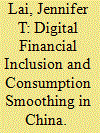| Srl | Item |
| 1 |
ID:
134853


|
|
|
|
|
| Summary/Abstract |
This paper investigates the extent to which idiosyncratic shocks to the permanent income of various provinces in China were mitigated through the channel of provincial risk-sharing during 1952–2008. Taking into account the possibility of self-insurance through saving, we find that provinces in China shared roughly 38% of their idiosyncratic output shocks during the entire sample period. In particular, we show that conventional risk-sharing analysis in the extant literature that does not take into account the self-insurance channel tends to over-estimate the degree of risk sharing by implying a degree of risk sharing of around 54%. Moreover, in view of the major economic reforms that had taken place in the last few decades, we decompose the sample period into two sub-phases: the pre-reform period (1952–1978), the reform period (1978–2008). We find that there is a notable increase in the degree of provincial risk sharing in the reform period. The degree of provincial risk sharing across China is comparable to that across the OECD countries, but falls short of that among the states in the US.
|
|
|
|
|
|
|
|
|
|
|
|
|
|
|
|
| 2 |
ID:
171881


|
|
|
|
|
| Summary/Abstract |
In this paper, we investigate the effect of digital nancial inclusion (DFI) on household consumption smoothing in China. We use four waves of the biennial China Family Panel Studies from 2010 to 2016, during which time DFI has signicantly developed alongside nancial technology across China. We split household income shocks into permanent and transitory components, and evaluate if DFI may help households to buffer against these shocks. We nd that households are not able to insure against permanent shocks to income, but they can smooth approximately 70 percent of transitory shocks to income. We also find that DFI has diminished households’ ability to insure against transitory income shocks. This is partly because online purchase may lead to the oversensitivity of consumption to income. In addition, we nd that contrary to DFI, traditional nancial sector development contributes to better household consumption smoothing against transitory income shocks
|
|
|
|
|
|
|
|
|
|
|
|
|
|
|
|